Daventry
Daventry (/ˈdævəntri/ DAV-ən-tree, historically /ˈdeɪntri/ DAYN-tree) is a market town and civil parish in western Northamptonshire, England, close to the border with Warwickshire. At the 2011 Census Daventry had a population of 25,026,[2] making it the sixth largest town in Northamptonshire. It is the administrative centre of the larger Daventry District, which had a population of 78,070 at the 2011 census.[3]
| Daventry | |
|---|---|
-_geograph.org.uk_-_1729537.jpg) Daventry, High Street, Market Square and market cross | |
 Daventry Location within Northamptonshire | |
| Population | 25,026 (2011 Census) |
| OS grid reference | SP5762 |
| Civil parish |
|
| District |
|
| Shire county | |
| Region | |
| Country | England |
| Sovereign state | United Kingdom |
| Post town | DAVENTRY |
| Postcode district | NN11 |
| Dialling code | 01327 |
| Police | Northamptonshire |
| Fire | Northamptonshire |
| Ambulance | East Midlands |
| UK Parliament | |
Geography
The town is 75 miles (121 km) north-northwest of London via the M1 motorway, 13.9 miles (22.4 km) west of Northampton, 10.2 miles (16.4 km) southwest of Rugby.[4] and 15.8 miles (25.4 km) north-north east of Banbury.
Other nearby places include: Southam, Coventry and the villages of Ashby St Ledgers, Badby, Barby, Braunston, Byfield, Charwelton, Dodford, Dunchurch, Everdon, Fawsley, Hellidon, Kilsby, Long Buckby, Newnham, Norton, Staverton, Welton, Weedon, and Woodford Halse. The town is twinned with Westerburg, Germany.
%2C_geograph-3640020-by-M-J-Richardson.jpg)
The town sits at around 110–210 m (360–690 ft) above sea level.[5] To the north and west the land is generally lower than the town. Daventry sits on the watershed of the River Leam which flows to the west of England and the River Nene which flows east. There is no river in the town and the largest gatherings of water are two reservoirs made to supply the canal that swings from Watford Gap into the west midlands through the 2,042 yd (1.867 km) long Braunston Tunnel around the north of the town. To the north west is Drayton Reservoir[6] and to the north east is the Daventry Reservoir and country park.
Watford Gap is about 4 miles (6.4 km) to the north east of the town. Through this gap pass the A5 (Watling Street Roman road), the Grand Union Canal, West Coast Main Line railway, the Northampton Loop Line and most recently the M1 motorway.
Daventry has several housing estates, which include: Drayton, Middlemore Farm, Lang Farm, Ashby Fields, Royal Oak, Timken, Stefen Hill, The Grange, The Southbrook, The Headlands and most recently Monksmoor Park.[7]
Characteristics
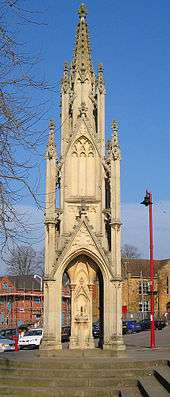
The town comprises a historic market centre surrounded by much modern housing and light industrial development. On the edge of the town centre is the popular Daventry Country Park and reservoir, just east of the A425.
There are 74 buildings or groups of buildings[8] in the centre of Daventry that are on the List of Buildings of Special Architectural or Historic Interest led by the Church of Holy Cross at grade I. Grade II* buildings include the Saracen’s Head (now Wetherspoons[9]), the Moot Hall (see below), the Wheatsheaf (now a residential home), 27, 29, 36, 57, 59 High Street and 2, 20, and 22 Sheaf Street. Grade II listed buildings include several in Market Place, Church Walk, New Street, High Street, Sheaf Street and the United Reformed Church, the Burton Memorial (commemorating Edmund Charles Burton, Town Clerk of Daventry;[10] see photo at left), Danetre Hospital Offices (former workhouse) and Middlemore Farmhouse (now a pub), also in Drayton – School Street and Orchard Street.
A street market is held every Tuesday and Friday in High Street,[11] although its original site was on the aptly named Market Square..
An alternative pronunciation for Daventry used by locals is 'Daintree', but this has become less common.[12][13]
Daventry is largely White, with little ethnic diversity; at the last census (2011) 95.4% of the town's residents described as 'White', the largest non-white ethnic group were Asians at 2.3%, (the largest sub-group of whom were Indian at 1.1%) 0.7% were Black, and 1.5% were Mixed.[14]
History
Early history
On the 653-foot-high (199 m) Borough Hill that overlooks the town, remains have been found of an Iron Age hill fort – one of the largest found in Britain. Remains have also been found on the hill of a Roman villa.
Thomas Pennant, the Welsh naturalist and antiquarian, acknowledged the town's 'considerable antiquity' and speculated that the name was Brythonic, dwy-afon-tre (town of two rivers), a derivation seemingly supported by the town's topography, situated as it is between the sources of the River Leam, which flows west, and the River Nene which flows east.[15][16] However, this seems fanciful given the location and the town's name is likelier to be Anglo-Saxon in origin: "Dafan tree" (tree of Dafa, Dafa being a personal name and "-n" being one of the Old English genitive suffixes), formed on lines similar to Coventry ("Cofan tree", i.e. "tree of Cofa").
Medieval
12th century Daventry had become home to a priory. In 1255 Daventry was granted a charter to become a market town. In 1576 Queen Elizabeth I granted Daventry borough status.
The town was mentioned by William Shakespeare in Henry VI, Part I, which refers to "the red-nosed innkeeper of Daintree".
The "Daintree" Shakespeare wrote about, the name persisting to this day, spelt Danetre, grew from a tradition that Danish settlers planted an oak tree on the summit of Borough Hill to mark the centre of England. This part of the town's history is reflected in the town's seal of a Viking/Saxon axeman and an oak tree. The town appears as Dauentre on the Christopher Saxton map of 1637.
English Civil War
During the English Civil War, the army of King Charles I stayed at Daventry in 1645 after storming the Parliamentary garrison at Leicester and on its way to relieve the siege of Oxford. The Royalist army, made up of 5,000-foot and as many horse, camped on Borough Hill (then spelt Burrow Hill) while Charles went hunting in the nearby forests.
According to local legend, it was during his stay at the Wheatsheaf Inn in Daventry that Charles was twice visited by the ghost of his former adviser and friend, Thomas Wentworth, 1st Earl of Strafford, who advised him to keep heading north and warned him that he would not win through force of arms.
However, Parliament's newly formed New Model Army, led by Sir Thomas Fairfax, was marching north from besieging Oxford after being instructed to engage the king's main army. Fairfax's leading detachments of horse clashed with Royalist outposts near Daventry on 12 June, alerting the king to the presence of the Parliamentary army. The Royalists made for their reinforcements at Newark-on-Trent but after reaching Market Harborough turned to fight, which resulted in the decisive Battle of Naseby. The village of Naseby is approximately 14 miles (23 km) northeast of Daventry.
Dissenters
English Dissenters founded a Dissenting chapel in the town around 1722 in buildings opposite The Wheatsheaf on the southern end of Sheaf Street. Later a Dissenting Academy was moved from Northampton to this site. The chemist and theologian Joseph Priestley studied there from 1752 to 1755.
Stagnation and decline 1840–1960
The main roads from London to Holyhead passed through Daventry and the town for centuries flourished as a coaching town. There were many coaching inns in the town of which only the Dun Cow, Saracens Head and the Coach and Horses remain as inns.
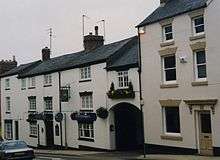
However, when the London and Birmingham Railway was opened in 1838 the coaching trade slumped and the town entered a long period of stagnation and decline which lasted for over a century. The Industrial Revolution largely passed Daventry by owing to its poor transport links. The canals passed around Daventry, although the Grand Junction Canal (now Grand Union) passed a few miles north. A branch from the Grand Union Canal to Daventry was proposed but was never built.[17]
The railways did not connect Daventry until quite late in the 19th century. Although the town was only a few miles from the main London to Birmingham line it took until 1888 before a branch line was built from Weedon to Daventry railway station. In 1895 the line was extended to Leamington Spa, although being only a branch line this failed to spur much growth. Daventry's economy remained largely rural, with shoemaking as the main industry.
Parish church

Holy Cross is the parish church of Daventry.[18] It has been the only Church of England church in the town, except when there was a daughter church of St James. In 1839 a Commissioners' church was built, architect Hugh Smith, and stood on the east side of St James Street. It was demolished in 1962. Holy Cross is the only 18th-century town church in Northamptonshire.[19] It was built between 1752 and 1758 by David Hiorne and is constructed of the local ironstone. The western elevation is broad with large pilasters at the angles and the angles of the centre bay. The entrance porch was added in 1951. The tower rises from the centre bay and is square ending with an obelisk spire rising above. Inside, the church has three wooden galleried aisles, to the north, south and west elevations. The pulpit is decorated with marquetry and fretwork and has a staircase with twisted balusters. Above the altar at the eastern elevation is a three-bayed Venetian stained glass window. There is heraldic glass in the two upper west windows. There are C18 and C19 grey and white marble wall monuments in the chancel, finely carved gallery monument of 1707, 1800 gallery monument by Cox, and 1741 by B Palmer.[20]
The Heritage at Risk Register for 2012[21] states that "Holy Cross is clearly well cared for and well maintained. However, some high level ironstone blocks and limestone balusters have weathered badly. Parapet and balustrade masonry is of particular concern. Some masonry fragments have already fallen. A grant was offered in December 2011" .. and, with locally raised funds and a large anonymous donation, work was carried out between May and October 2013.
The bells
Some time after 1550 a new Gothic church was erected, and in 1700 Bridges[22] records the inscriptions of the five bells then hanging in the tower, some of which bore the name of the Watts foundry of Leicester. They are also shown by North in his Church Bells of Northamptonshire (1877).[23] In 1738, these five, together with three other bells formerly hanging in the tower of Catesby Priory, were recast by Thomas Eayre, of Kettering, into a fine ring of eight with a 16+ cwt. tenor. They were rehung in the new tower in 1754, and with the exception of the 6th, which was recast by Joseph Eayre at St. Neots in 1764, they survived intact until 1908, when the tenor, having become badly cracked, was recast with added metal by John Taylor & Co. In 1915 the 7th fell in two pieces during service ringing one Sunday and this, too, was recast at Loughborough. By 1938 the bells were badly in need of rehanging, and the old oak frame was strengthened and the bells hung on cast iron headstocks and ball-bearings. Another bell, the 3rd, became cracked in 1951 and was recast. Inspection by Frederick Sharpe in 1960 and later by Taylors revealed that the frame was once again moving considerably, and the bells were consequently not always easy to ring—particularly the tenor. The cause was found to be the ends of the massive supporting beams which had rotted in the walls. The enthusiasm of the local ringers led to the decision to install a frame for ten and to add two new trebles; at the same time it was thought advisable to recast the old treble, 2nd and 4th—the ringers undertaking to pay for two of them. The dedication of the newly restored bells coincided with the visit of the Central Council of Church Bell Ringers to Northampton in 1965, and it is not merely local pride to say that they are among the very finest light rings of ten bells to be found anywhere.[24]
After 50 years of continual use, a survey by John Taylor & Co of Loughborough recommended a series of jobs needed on the installation to bring it back to 'as new' condition, which were put in hand during 2015.
The single bell removed from St James' Church, when it was demolished in 1962, is kept in the ringing room of Holy Cross. It has the inscription 'Thomas Mears Founder London 1839', diameter 22 7/16 inches and weighs 2cwt 2qrs (127 kg).
The Moot Hall
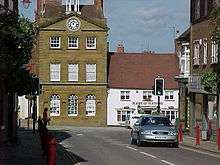
The Moot Hall stands on the north side of the market square next to the Plume of Feathers inn. It was built in 1769[19] from ironstone and has had various uses over the years, including town council building, a women’s prison, the mayor's parlour, town museum and tourist information office, an Indian restaurant and an antiques centre.
It is of two and a half storeys, and has three bays of windows. The main entrance and its porch is on the western elevation where the building is connected to a house built in 1806. The original staircase from the Moot Hall is now installed at Welton Manor House.[19]
Broadcasting station
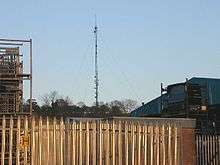
In 1925, the newly created BBC constructed a broadcasting station on Borough Hill[25] just outside the town. Daventry was chosen because it was the point of maximum contact with the land mass of England and Wales. From 1932 the BBC Empire Service (now the BBC World Service) was broadcast from there. The radio announcement of "Daventry calling" made Daventry well-known across the world. It was the BBC's use of the literal pronunciation in this call-sign that resulted in the widespread displacement of the historical pronunciation "Daintree" (ˈdeɪntri), though the latter is still used in some circumstances locally, as in the name of Danetre Hospital.
On the early morning of Tuesday 26 February 1935 the radio station at Daventry (Borough Hill) was used for the first-ever practical demonstration of radar, by its inventor Robert Watson-Watt and Arnold Frederic Wilkins, who used a radio receiver installed in a trailer at Stowe Nine Churches (just off the A5 about three miles (5 km) south of Weedon Bec and in the Daventry district) to receive signals bounced off a metal-clad Handley Page Heyford bomber flying across the radio transmissions. The interference picked up from the aircraft allowed its approximate navigational position to be estimated.
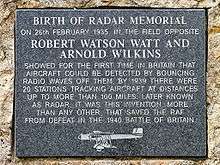
The station closed in 1992 and only one of the radio masts now remains. A busy directional radio beacon (VOR), identifier "DTY", for aircraft is situated approximately 4 miles (6.4 km) south of the town. The town also gives its name to the busy Daventry air traffic control sector.
75 years to the day of the original launch, on 26 February 2010, teams from the Coventry Amateur Radio Society & The Northampton Radio Club re-enacted the 'Daventry Experiment'. Signals from GB75RDF at Borough Hill, reflected from aircraft (all of which were flown by radio hams), were detected in a receiving set housed in a replica Morris van. The receiving station set up in the field that is the home to The Birth of RADAR memorial at Litchborough. The team was led by Brian Leathley, known as Andrew G8GMU.[26]
Borough Hill was also the site of the Gee Eastern chain master transmitter mast: this was part of a radio navigation system used by the Allies during World War II.[27] Borough Hill Roman villa is also located here.
Modern times
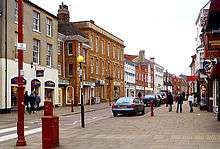
The modern growth of Daventry occurred from the 1960s onwards as part of a planned expansion of the town.
Daventry remained a small rural town until the 1950s; in 1950 it had a population of around 4,000. Real growth started in 1955 when the tapered roller bearing manufacturer British Timken located a large factory in the town (the factory closed in 1993 although the distribution Centre stayed open until 2000).[28]
In the early 1960s, Daventry was designated as an 'overspill' to house people and industry moved from Birmingham; a planned expansion was carried out as part of an agreement with Birmingham City Council. The first phase of this expansion was constructed on the south-east slopes of Borough Hill and was named the Southbrook Estate. It was designed and laid out by the architect J A Maudsley[29] for City of Birmingham Architects Department. This began in 1966.[29] and is designed with short terraces of dwellings grouped around a series of cul-de-sacs[29] grouped around a large looped access road around the edge of the hill. There is a central focal point which has schools for children from early years to senior level. There are several service shops and originally there was an estate public house but that was demolished in the mid 1990s. There is also a community centre.
The town's plan did not, however, live up to expectations. The target population was 36,000 by 1981, but actual growth was much slower than this; nevertheless, by 1981 the population had climbed to 16,178; by 2001 it was 22,367 and by 2011 it was 25,026. More recently, a new wave of development has been proposed which could take the town's population to about 40,000 by 2021.[30]
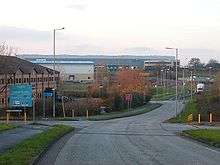
Daventry was struck by an F0/T1 tornado on 23 November 1981, as part of the record-breaking nationwide tornado outbreak on that day.[31] In 1995 RAF Daventry was listed as a USAF communication facility by the then Minister of State for the Armed Forces Nicholas Soames in answer to a question from Max Madden.[32] RAF Daventry is most likely the transmitter base at a former WW1 isolation hospital site on the Staverton to Newnham road which was eventually sold by the Ministry of Defence in 2007.
In 2006, the outdoor pool – which had been built and funded by Daventry residents in the 1950s following the drowning of three children in the local reservoir – was closed due to funding difficulties.[33] In 2007, Daventry began plans to modernise the town with a futuristic personal rapid transit system that would link outer estates to the town centre, and a canal arm with marina next to the former site of the outdoor pool. In May 2018, the District Council dropped the building a canal arm and marina scheme in favour of achievable projects.[34]
In November 2012, it was announced by ITV Studios that a series of the popular Channel 4 show Come Dine With Me will be filmed in Daventry and surrounding villages.[35]
In March 2018, the town's High Street was used as a filming location for the feature film, Nativity Rocks!, starring Craig Revel Horwood, Bradley Walsh, Meera Syal, Helen George, Ruth Jones, Celia Imrie, Hugh Dennis and Anna Chancellor.
Politics and government
In 1974, the old borough of Daventry was abolished and merged into the new Daventry District, which also includes a large rural area. In 2003, Daventry became a civil parish and gained its own Town Council. The Town Council currently has 17 members representing seven wards which differ from the wards of the district council. The Mayor of Daventry is elected annually by the members of the town council.[36]
Due to financial and cultural mismanagement by the cabinet and officers at Northamptonshire County Council, in 2018 the then Secretary of State for Local Government, Sajid Javid, sent commissioner Max Caller into the council, who recommended the county council and all district and borough councils in the county be abolished, and replaced by two unitary authorities, one covering the West, and one the North of the county. If these proposals go ahead then the districts of Daventry, Northampton and South Northamptonshire would be merged to form one of the unitary authorities, and the other would consist of Corby, East Northamptonshire, Kettering and Wellingborough districts.[37]
Daventry is represented in Parliament by the Daventry constituency, which is a safe Conservative seat, the MP representing the seat since 2010 has been Chris Heaton-Harris.
Local economy
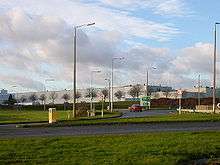
Cummins have their largest UK plant at the town where they manufacture some of their largest diesel engines that are suitable for marine, railcar and generator set uses.
The proximity of motorways and mainline railways has led to the development of an increasingly large logistics facility, north of Daventry. This warehousing and distribution centre is known as the Daventry International Rail Freight Terminal (DIRFT). It is situated between Rugby and Crick and the A5 and junction 18 of the M1 motorway (its original northern terminus in 1959 until 1964). Stagecoach Midlands provides regular bus services D1 and D2 from Daventry and Rugby. The terminal is served by a direct connection to the Northampton Loop of the West Coast Main Line railway.
Due to the proximity to the M1, Ford[38] opened a large national spare parts distribution warehouse on the Royal Oak Industrial Estate in 1972. The 130-acre (0.53 km2) building, took Taylor Woodrow a year to build at a cost of £2.25 m and was for many years considered the largest building in the United Kingdom.
A new national distribution centre was opened in 2004, run by DHL, for J D Wetherspoon on the Drayton Fields Industrial Estate, north west of the town.
In 2011 a landmark building was opened in Eastern Way – the iCon. It provides conferencing and 55 supported units for businesses involved in low carbon construction and environmental technologies. It also includes a café, exhibition space and an auditorium for 300 people. Funding for the project came from the European Regional Development Fund, the East Midlands Development Agency and the West Northamptonshire Development Corporation. Daventry District Council and Northamptonshire County Council have donated the land for the project. It is now operated by the University of Northampton.
Transport
Road
Daventry is near the M1 motorway with access to two junctions: 18 to the northeast and 16 to the southeast of the town.
Access to the town is from junction 16 of the M1 via the A45 which since 2018 follows a new road bypassing Flore and Weedon and then forms a ring -road to the south and west bypassing the town centre via Stefen Way, merging with the A425 along Leamington Way and continuing through Dunchurch to Coventry. The A425 acts as a ring road to the east of the town centre.
The town is also served by junction 18 of the M1 and via a short stretch of the A5 to the northern end of the very long A361.
From the south west there is access from junction 11 of the M40 along the A361.
Bus
Local and regional bus services are provided by Stagecoach Midlands[39] from their bases in Northampton, Rugby and until December 2016, Leamington Spa. Stagecoach in Oxfordshire provides an hourly service to Banbury. Villages without a regular connection to Daventry had a bookable County Connect[40] bus service run by Centrebus under a County Council contract until 1 September 2014 when the operator changed to Kier Fleet Passenger Services. All subsidies for bus services in Northamptonshire have been discontinued due to financial mismanagement at Northamptonshire County Council meaning most of these bus services will end.[41]
Railways
Daventry once had its own railway station on the former London and North Western Railway branch-line from Weedon to Leamington Spa, which opened in 1888 and was closed on 15 September 1958 and is now demolished. Daventry is now one of the largest towns in England without its own railway station.[42]
In addition to this the former Braunston and Willoughby railway station on the Great Central Main Line which ran to the west of Daventry, was originally called Willoughby for Daventry when it opened in 1899, despite the station being around five miles north-west of Daventry in neighbouring Warwickshire. It was later renamed Braunston and Willoughby for Daventry in 1904, before the reference to Daventry was finally dropped in 1938. The station itself closed in 1957, and the line in 1966.[43]
The nearest railway station to Daventry today is Long Buckby railway station around four miles to the north-east, where access is gained to West Midlands Trains services to Birmingham New Street, Northampton and London Euston via the Northampton loop of the West Coast Main Line. Inter-city services (Avanti West Coast and West Midlands Trains) can be accessed from Rugby railway station - Stagecoach buses D1 and D2 from Daventry and Banbury railway station (Chiltern Railways, CrossCountry and Great Western Railway) - Stagecoach bus 200 from Daventry.
Air
The nearest major international airport is Birmingham Airport.
Education
Sixth form provision in the town has been confounded by successive Government policies. From September 1989, the County Council decided to close the newest of the three comprehensive schools (The Grange) and strip the Parker E-ACT Academy and DSLV of their sixth forms. The Grange site was converted to become Daventry Tertiary College, providing education and training for 16- to 18-year-olds. When Government moved control of Further Education colleges and their assets in 2001 from county councils to the Learning and Skills Council, the Tertiary College was included. To provide greater financial and professional support, it became part of Northampton College in August 2004. Due to the strong and popular attractions of the sixth forms of nearby Rugby schools, the Daventry Learning Partnership was set up by the two secondary schools and the college (and later included Moulton College) to jointly provide a more competitive offering. After the county councils had failed in efforts to reduce the attraction of the Rugby schools, it was decided in 2010 to reintroduce sixth forms to the two Daventry secondary schools, both of which have now transformed into academies.
Today, Daventry has two secondary schools: The Parker E-ACT Academy to the north of the town and Danetre and Southbrook Learning Village[44] to the east, near the BBC transmitter, both with thriving sixth-forms and the Daventry campus of Northampton College. In September 2013 Daventry University Technical College opened. It was part of the university technical college programme, and offered 14–19 year old students technical as well as academic courses of education. After failing to attract enough pupils the college closed at the end of the 2016-17 school year, lasting only four years.
Primary education facilities include St James' Junior School, Falconer's Hill Academy, Abbey Church of England Academy, Ashby Fields Primary School – which is a values-based school, The Grange School and the primary part of the Danetre and Southbrook Learning Village. Monksmoor Park CE Primary School opened in September 2018. Many children from Daventry are enrolled with the surrounding village schools, such as Byfield, Badby, Newnham, Woodford Halse, Barby, Monksmoor Park and Welton.
Sport and leisure
Daventry has a Non-League football team, Daventry Town F.C., who play at Communications Park. Daventry United F.C. folded at the end of the 2011–12 season.
The town's Stefen Hill Sports Ground is home to Daventry Amateur Athletic Club[45] and Daventry Rugby Club.[46]
The town has two main public parks, Daventry Country Park, which features a large children's play area, fitness equipment, a range of marked walks, nature trail, and cafe, and Daventry reservoir. The smaller Daneholme park is quite close by and is bounded by the old railway cuttings, Daneholme Avenue, Ashby Road and Welton Road.
There is a leisure centre[47] in the town centre which is well attended. It features swimming pool area, gym and a number of multi-sport areas. A children's soft play area and cafe provide non-sports-based facilities.
Golfers can enjoy the course at Daventry and District Golf Club,[48] which is effectively on the side of Borough Hill, or head slightly out of town to Staverton Park Golf Club.[49]
2013 saw the opening of a purpose-built skate park[50] on New Street Recreation Ground, this was constructed in consultation with local youth groups and features challenges for boarders of all abilities.
On 7 June 2017 a major cycling event took place in the town when Daventry hosted the Grand Depart of The Women's Tour. The first stage started on the High Street and completed a lap of the town before heading off to finish in Kettering.[51] On 14 June 2018 The Women's Tour stage two began in Rushden and finished in the High Street in Daventry.[52]
Local media
The local weekly newspaper serving the town is the Daventry Express.[53]
See also
- The hamlet of Drayton, now a suburb of Daventry.
- Stagecoach Midlands bus routes in Northamptonshire and Warwickshire
- Stagecoach in Oxfordshire bus route to Banbury
- Grade I listed buildings in Daventry (district)
- Grade II* listed buildings in Daventry (district)
References
Citaitons
- https://www.daventrytowncouncil.gov.uk/
- "DAVENTRY Parish in East Midlands". City Population. Retrieved 3 February 2019.
- "DAVENTRY District in Northamptonshire (United Kingdom)". City Population. Retrieved 3 February 2019.
- Ordnance Survey Explorer Map, Rugby & Daventry 222, ISBN 978-0-319-23734-2
- "Daventry Pages 62-72 An Inventory of the Historical Monuments in the County of Northamptonshire, Volume 3, Archaeological Sites in North-West Northamptonshire". British History Online. 1981. Retrieved 4 February 2019.
- "Fisheries.co.uk – Canal and River Trust Drayton Reservoir, Daventry, Northamptonshire". Retrieved 3 May 2016.
- "SuperDevelopmentPage".
- Good Stuff. "Listed Buildings in Daventry, Northamptonshire, England – British Listed Buildings". Retrieved 3 May 2016.
- "The Saracens Head Inn". Retrieved 3 May 2016.
- "The Burton Memorial, Market Square, Daventry, Northamptonshire. - Citizen Memorials on Waymarking.com". Retrieved 3 May 2016.
- "High Street". Archived from the original on 1 July 2012. Retrieved 10 January 2013.
- "History of Daventry in Northamptonshire – Map and description". Retrieved 3 May 2016.
- "Denty Family Crest, Coat of Arms, Name History and Name Meaning". HouseOfNames. Retrieved 3 May 2016.
- UK Census (2011). "Local Area Report – Daventry Parish (1170216531)". Nomis. Office for National Statistics. Retrieved 3 February 2019.
- Datchworth – Dean, West | A Topographical Dictionary of England (pp. 15–23). British-history.ac.uk (2003-06-22). Retrieved on 2013-07-17.
- Pennant, Thomas. "Journey from Chester to London". Vision of Britain.
- "Daventry Canal Association". History. Daventry. 2011. Retrieved 29 June 2011.
- "welcome - Holy Cross Church Daventry". www.holycrosschurchdaventry.org.uk.
- The Buildings of England, Northamptonshire, by Nikolaus Pevsner, 2nd Edition revised by Bridget Cherry, p. 173. ISBN 0-14-071022-1
- Good Stuff. "Church of the Holy Cross – Daventry – Northamptonshire – England – British Listed Buildings". Retrieved 3 May 2016.
- , Heritage at Risk 2012 – see page 61.
- The History and Antiquities of Northamptonshire (published in 1790 although the material was gathered earlier)
- https://archive.org/stream/churchbellsofno00nort#page/242/mode/2up/search/daventry
- The Ringing World p710 September 11, 1970
- "Archived copy" (PDF). Archived from the original (PDF) on 24 December 2013. Retrieved 17 July 2013.CS1 maint: archived copy as title (link)
- "G8GMU Birth of RADAR 26th Feb 2010 page". www.andrewphotographic.co.uk. Retrieved 18 September 2019.
- "It's time to pay our respects to US airmen who died in Daventry". Retrieved 3 May 2016.
- "BBC News – BUSINESS – British Timken to axe 950 jobs". 26 April 2001. Retrieved 3 May 2016.
- Pevsner, Nikolaus (1998). Northamptonshire – The Buildings of England. Description of the Southbrook Estate and reference to J A Maudsley. Penguin Books. p. 175. ISBN 9780140710229.
- "West Northamptonshire Development Corporation Vision for Daventry". Archived from the original on 9 June 2009. Retrieved 16 June 2009.
- "European Severe Weather Database".
- "Archived copy". Archived from the original on 3 March 2016. Retrieved 2014-10-19.CS1 maint: archived copy as title (link)
- "Outdoor pool shuts after 40 years". BBC News. 4 September 2006.
An outdoor swimming pool, built following the deaths of five children in a reservoir, is shut down.
- "Meetings". Retrieved 13 June 2018.
- Come Dine With Me casting in Daventry – Local. Daventry Express (2012-10-25). Retrieved on 2013-07-17.
- "Daventry Town Council". Retrieved 3 May 2016.
- "Northamptonshire County Council: statement". Retrieved 13 June 2018.
- "Login* | Blue Oval Club (UK)". www.fordpartsplus.co.uk.
- "Timetables". Retrieved 3 May 2016.
- "CountyConnect – public transport, bus services". Retrieved 3 May 2016.
- "CUTS U-TURN: Slashed bus subsidies will take us back to the 'Stone Age' fears Northamptonshire villager". Chronicle & Echo. Retrieved 13 June 2018.
- "Daventry Town Transport Strategy" (PDF). Northamptonshire County Council. Retrieved 4 February 2019.
- Butt, R.V.J. (1995). The Directory of Railway Stations. Yeovil: Patrick Stephens Ltd. ISBN 1-85260-508-1. R508.
- "Danetre and Southbrook Learning Village – An all through academy for 3 to 19 year olds". Retrieved 3 May 2016.
- "Daventry Amateur Athletic Club – Just another WordPress site". Retrieved 3 May 2016.
- "Daventry Rugby Club". Retrieved 3 May 2016.
- "» Daventry Leisure Centre". Retrieved 3 May 2016.
- "daventry golf club". Retrieved 3 May 2016.
- "Northamptonshire Golf Club – Daventry Staverton Park". Retrieved 3 May 2016.
- "skate park".
- "The Women's Tour". 16 February 2017.
- "Tour set for a triumphant return".
- Daventry Express
Bibliography
- Greenall, R. L. (1999). Daventry Past. Chichester, West Sussex: Phillimore & Co. ISBN 1-86077-108-4.
External links
| Wikimedia Commons has media related to Daventry. |
